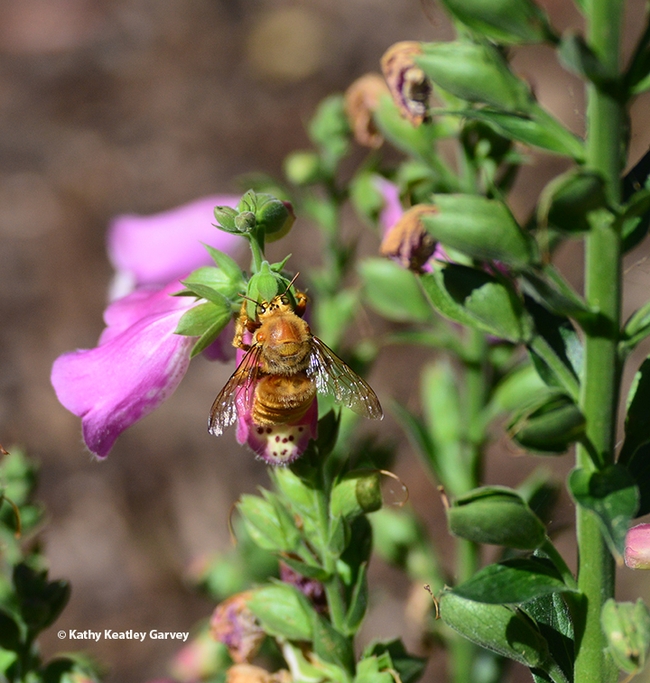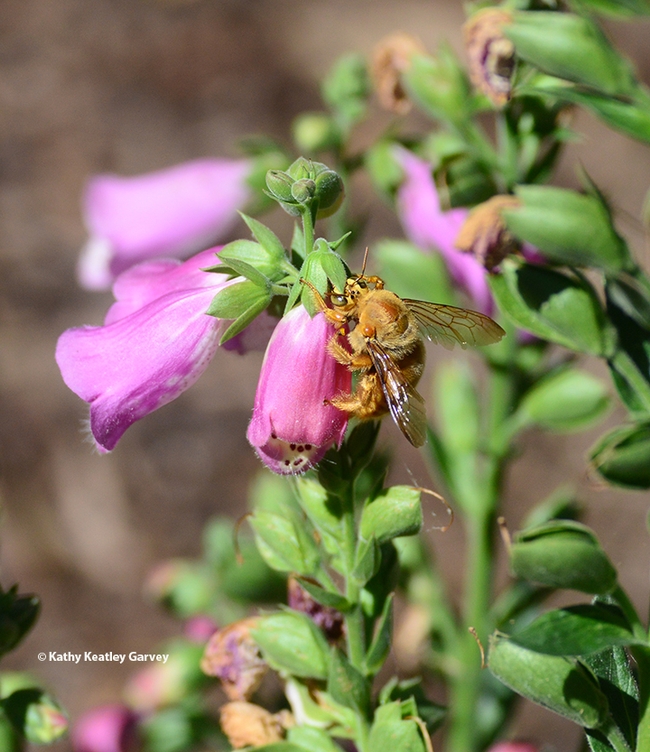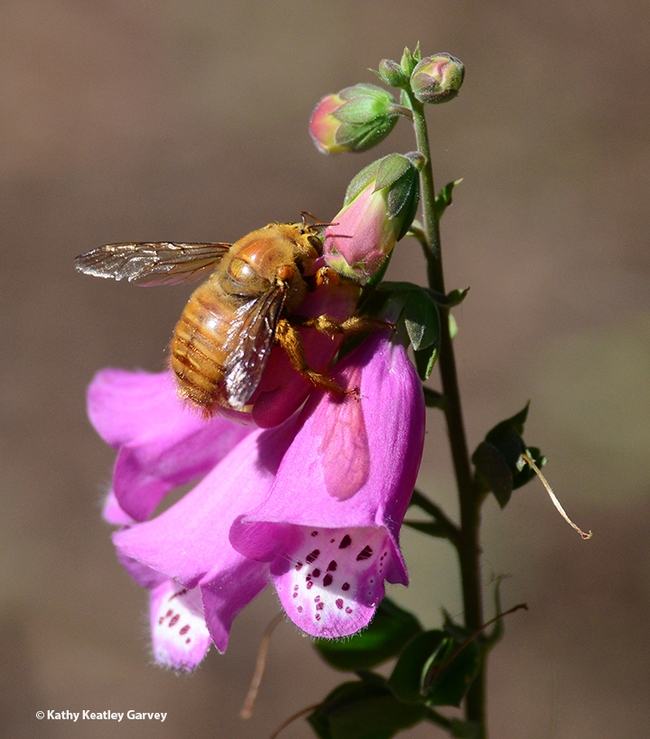- Author: Kathy Keatley Garvey
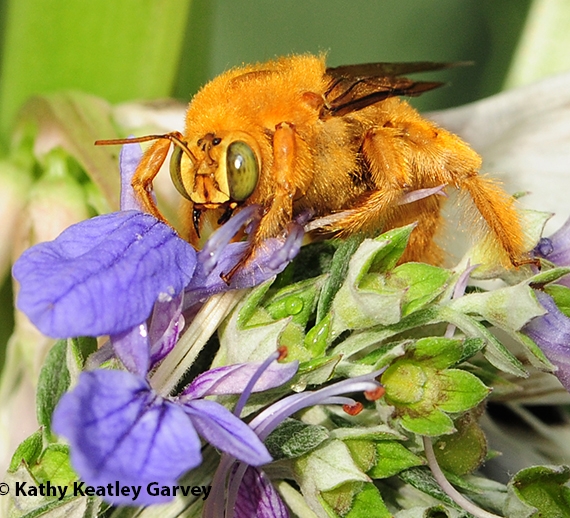
On Oct. 17?
But there he was, the familiar golden bee with green eyes, robbing nectar from a Mexican petunia, Ruellia simplex, in a Vacaville, Calif., garden.
"Nectar robbing" occurs when a bee bypasses the pollination process and "cheats" by entering a flower from the outside to steal the nectar. This one proved to be a good robber, as he buzzed from blossom to blossom to drill holes in the corolla and sip the nectar.
This is the bee that the late Robbin Thorp, distinguished emeritus professor, UC Davis Department of Entomology and Nematology, called "the teddy bear bee." It looks fluffy and cuddly and it doesn't sting. Or as Thorp used to say, "Boy bees don't sting." Often he would show a newly collected male Valley carpenter bee to youngsters at a Bohart Museum of Entomology open house (in the spring) and encourage them to hold him. You could see the utter delight on their faces.
Valley carpenter bees are a perfect example of sexual dimorphism. The females are solid black and the males are golden with green eyes. (See more information about wild bees in the book California Bees and Blooms: A Guide for Gardeners and Naturalists by University of California-affiliated authors Gordon Frankie, Robbin Thorp, Rollin Coville, and Barbara Ertter.)
As Thorp told us several years ago for a news story: This Valley carpenter bee (formerly known as as Xylocopa varipuncta) "occurs in the Central Valley and southern California, Arizona, New Mexico and southward through Mexico. It is large (about the size of a queen bumble bee), with all black females and golden/buff-colored males with green eyes. Females have dark wings with violet reflections."?
Some folks think it's a pest. It's not. It's a pollinator.
And if you spot a male in October, just call it "Mr. October." Baseball Hall of Famer Reggie Jackson probably wouldn't mind.
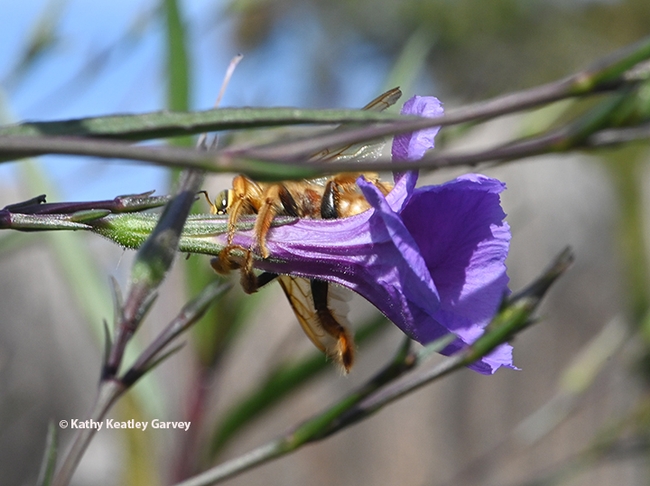
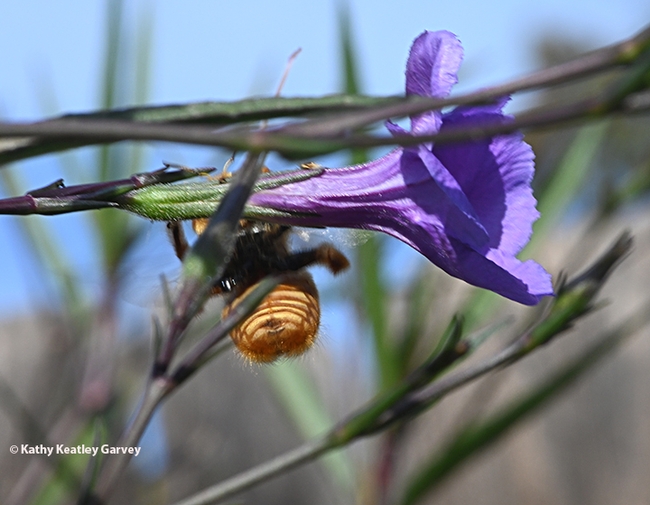
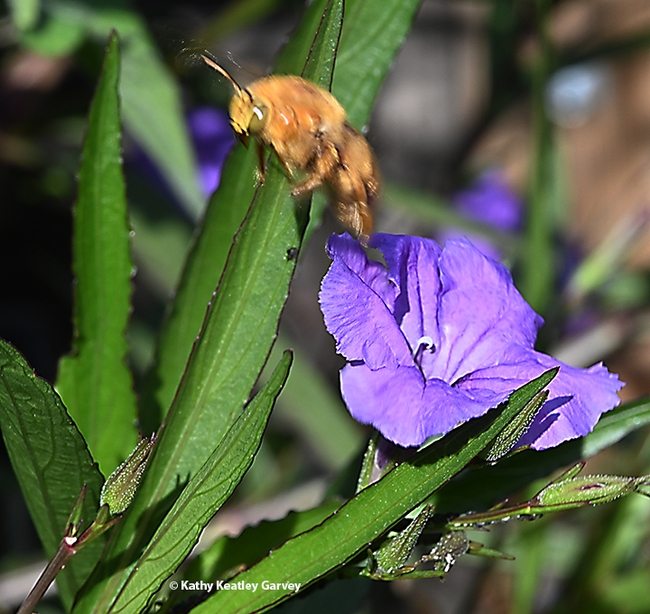
- Author: Kathy Keatley Garvey
It's always a good idea to carry your cell phone or shoulder a camera while you're taking a stroll through a garden.
You never know what you will see.
It was early morning on Tuesday, June 7, when we spotted a female Valley carpenter bee, Xylocopa sonorina, asleep on a passionflower vine, Passiflora. That's the host plant for the Gulf Fritillary, Agraulis vanillae, but carpenter bees are always hanging around for pollination. Tiny grains of golden pollen cling to this bee look like gold dust.
The females are solid black, while the males are a golden blond with green eyes. Sexual dimorphism. These bees are found in the Central Valley and southern California, Arizona, New Mexico and southward through Mexico, according to the late native pollinator specialist Robbin Thorp, UC Davis emeritus professor of entomology. He described them as "the largest of the carpenter bees in California."
Wikipedia indicates Valley carpenter bees are found from western Texas to northern California, and the eastern Pacific islands. Frederick Smith, assistant in the Zoological Department of the British Museum and member of the council of the Entomological Society of London, first described X. sonorina in 1874 from specimens collected in Hawaii, according to Wikipedia. "Until 1956, it was thought that X. sonorina came from the Sunda Islands, but in a paper published that year,M. A. Lieftinck showed that Smith's interpretation of the original specimen labels was in error: Smith had mistakenly read the label of X. sonorina as meaning the Sunda Islands instead of the Sandwich Islands."
"In 1899, R. C. L. Perkins described the same species as Xylocopa aeneipennis, and in 1922, P. H. Timberlake claimed that the Hawaiian Xylocopa was the same as the mainland X. varipuncta, that had been named in 1879, and Roy Snelling predicted in 2003 that X. varipuncta would eventually be reclassified as a synonym of X. sonorina," Wikipedia relates. "This was confirmed in 2020 using DNA analysis, and as the name sonorina has seniority, this is the valid species name."
Up until 2020, we'd always called them X. varipuncta.
This week we called one "sleepy head."
Ms. Valley Carpenter Bee finally stirred and soon after, took flight.
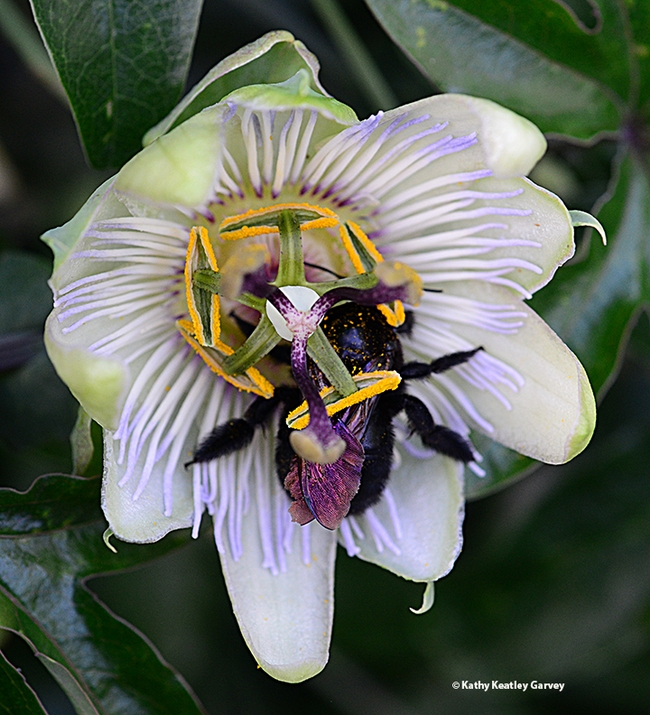
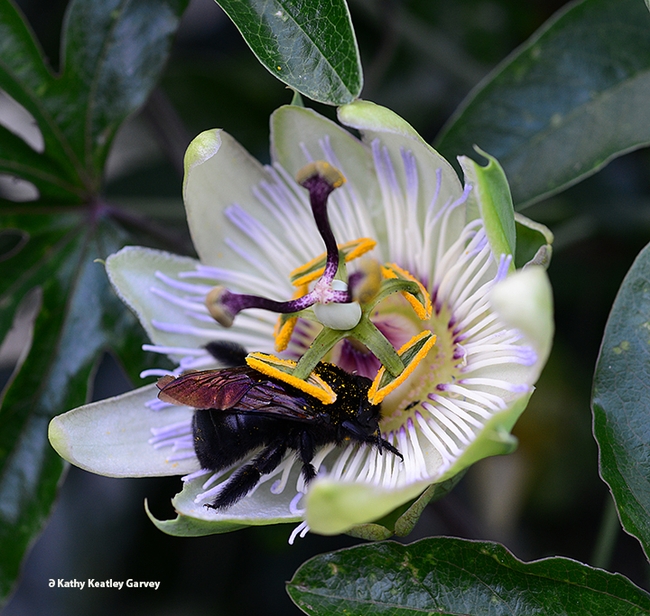
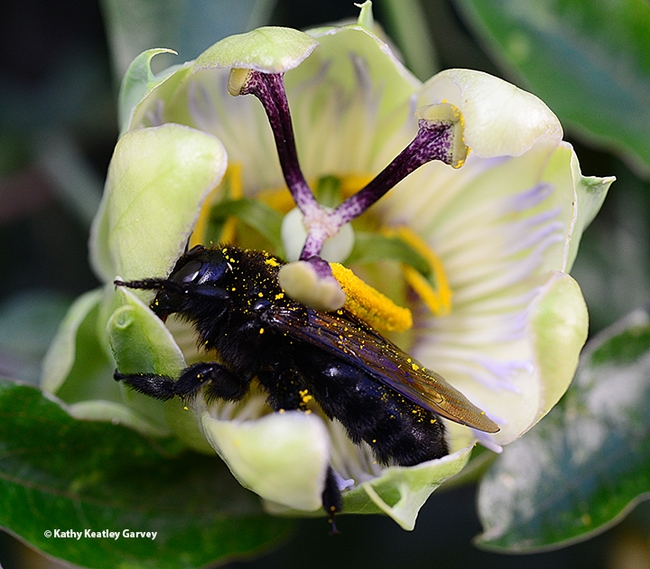
- Author: Kathy Keatley Garvey
There's a way for a bear to outsmart a fox.
A teddy bear bee, that is.
We just witnessed a male Valley carpenter bee, Xylocopa sonorina, aka "the teddy bear bee," buzz up to a patch of foxgloves, Digitalis purpurea.
Then he engaged in the foraging behavior known as nectar-robbing. That's when a carpenter bee or bumble bee drills a hole at the base of the corolla--or finds a hole already drilled--and "robs" the nectar, bypassing the flower's reproductive parts that lead to pollination.
Hey, I'm not going through the front door! I'm not! I'm taking the back door.
We usually see female Valley carpenter bees drilling the holes and robbing the nectar. This time, though, it was a male. The late Robbin Thorp, UC Davis distinguished emeritus professor of entomology, always referred to the males as "teddy bear bees," adding "boy bees don't sting."
This particular teddy bear lingered a bit, sipped some nectar, and then took flight.
That's how a "bear" outsmarts a fox.
By the way, sexual dimorphism is pronounced in X. sonorina. The male is a green-eyed blond, while the females are solid black.
In our garden, other plants popular for nectar robbing include the salvias, ‘Hot Lips' Sage (Salvia ‘Hot Lips'), and California fuchsia (Epilobium canum). Sometimes you'll see a honey bee following a carpenter bee or bumble bee around to gain easy access to the nectar. She "knows the drill."
Scientists have known about nectar-robbing for more than two centuries. German naturalist Christian Konrad Sprengel observed bumble bees perforating the corollas of flowers as early as 1793, according to Wikipedia. Sprengel recorded this phenomenon in his book, The Secret of Nature in the Form and Fertilization of Flowers Discovered. Charles Darwin observed nectar robbing (by bumble bees) in 1859 and published his observations in his book The Origin of Species.
